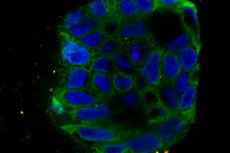Researchers have discovered a new way for cancer cells to die during chemotherapy
Sist anmeldt: 14.06.2024

Alt iLive-innhold blir gjennomgått med medisin eller faktisk kontrollert for å sikre så mye faktuell nøyaktighet som mulig.
Vi har strenge retningslinjer for innkjøp og kun kobling til anerkjente medieområder, akademiske forskningsinstitusjoner og, når det er mulig, medisinsk peer-evaluerte studier. Merk at tallene i parenteser ([1], [2], etc.) er klikkbare koblinger til disse studiene.
Hvis du føler at noe av innholdet vårt er unøyaktig, utdatert eller ellers tvilsomt, velg det og trykk Ctrl + Enter.

Chemotherapy destroys cancer cells. But the way these cells die appears to be different from previous understandings. Researchers from the Netherlands Cancer Institute, led by Thein Brummelkamp, have discovered a completely new way of cancer cell death: due to the Schlafen11 gene.
"This is a very unexpected discovery. Cancer patients have been treated with chemotherapy for almost a century, but this pathway to cell death has never been observed before. Where and when does this occur in patients, needs to be further explored. This discovery may ultimately have implications for the treatment of cancer patients." They published their results in Science.
Many cancer treatments damage the DNA of cells. After too much irreversible damage, cells can initiate their own death. School biology teaches us that the p53 protein takes control of this process. P53 mediates the repair of damaged DNA, but initiates cell suicide when the damage becomes too severe. This prevents uncontrolled cell division and cancer formation.
Surprise: Unanswered Question
This sounds like a reliable system, but the reality is more complex. "In more than half of tumors, p53 no longer functions," says Brummelkamp. "The main player p53 doesn't play any role there. So why do cancer cells without p53 still die when you damage their DNA with chemotherapy or radiation? To my surprise, this turned out to be an unanswered question."
His research team then discovered, together with colleague Revuen Agami's group, a previously unknown way in which cells die after DNA damage. In the laboratory, they injected chemotherapy into cells in which they carefully modified the DNA. Brummelkamp says: "We were looking for a genetic change that would allow cells to survive chemotherapy. Our group has a lot of experience in selectively turning off genes, which we could fully apply here."
A New Major Player in Cell Death By knocking out the genes, the research team discovered a new pathway to cell death led by the gene Schlafen11 (SLFN11). Principal investigator Nicholas Boon said: "When DNA is damaged, SLFN11 turns off the cells' protein factories: the ribosomes. This causes enormous stress in these cells, leading to their death. The new pathway we discovered bypasses p53 completely."
The SLFN11 gene is not new to cancer research. It is often inactive in tumors from patients who do not respond to chemotherapy, Brummelkamp says. "We can explain this connection now. When cells lack SLFN11, they do not die in this way in response to DNA damage. The cells will survive and the cancer will continue."
Impact on cancer treatment
"This discovery opens up many new research questions, which is usually the case in basic research," says Brummelkamp.
"We demonstrated our discovery in cancer cells grown in the laboratory, but many important questions remain: Where and when does this pathway occur in patients? How does this affect immunotherapy or chemotherapy? Does it affect the side effects of cancer treatment? If this form of cell death will also be significant for patients, this discovery will have implications for cancer treatment. These are important questions for further study."
Turning off genes, one at a time Humans have thousands of genes, many of which have functions we don't understand. To determine the roles of our genes, researcher Brummelkamp developed a method using haploid cells. These cells contain only one copy of each gene, unlike normal cells in our bodies which contain two copies. Handling two copies can be difficult in genetic experiments because changes (mutations) often occur in only one of them. This makes it difficult to observe the effects of these mutations.
Together with other researchers, Brummelkamp has spent many years uncovering the processes that are critical to disease using this versatile method. For example, his group recently discovered that cells can produce lipids in a different way than previously known.
They have uncovered how certain viruses, including the deadly Ebola virus, manage to enter human cells. They delved into cancer cells' resistance to certain therapies and identified proteins that act as brakes on the immune system, which has implications for cancer immunotherapy.
In recent years, his team has discovered two enzymes that remained unknown for four decades and are found to be vital for muscle function and brain development.
